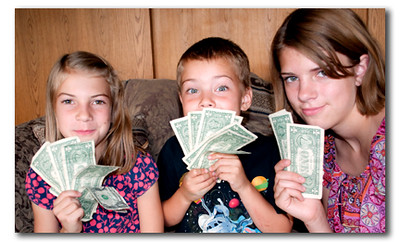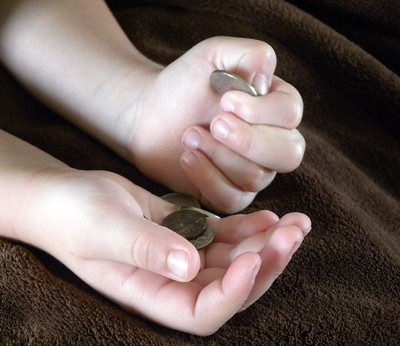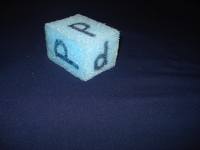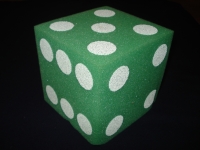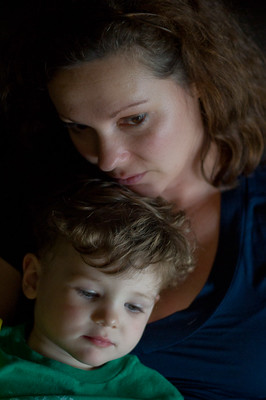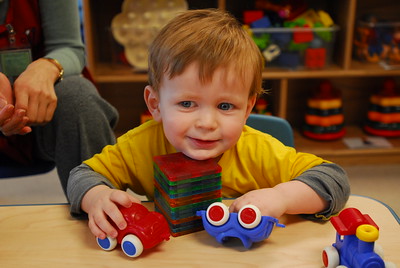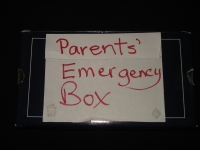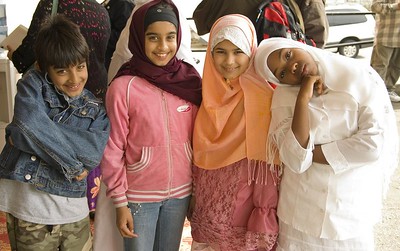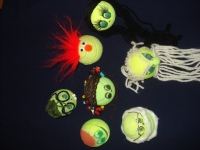Find many creative ideas to get children leaping ahead in their physical development, all while done with things found at home. This is the time to take a minute to watch these and strengthen your options while stuck at home. Enjoy!
Building on "Teaching Kids About Money, Part 1" and "Part 2," the following practical ideas can be considered:
Money games for pre-schoolers to help them learn the worth of money:
- Take file cards and trace around coins. The child can try to fit coins into the spots. Make cards in which the value is explained. One traced nickel equals five traced pennies, one dime equals two traced nickels, and so on. (This is a tough concepts for youngins, since the dime is smaller than a nickel but worth more.)
Note: children like handling coins. Do so for a short time. Do not do it until they lose interest. And do not do it around littles who put them in their mouths. Older children can play with these cards on a tray or box lid to keep it out of reach of younger siblings.
In Teaching Kids About Money, Part 1, we laid a foundation about beginning to help your children think about money -- immediate and delayed gratification, spending, and generosity. In Part 2, we set a few more helpful concepts in place before giving some practical games for teaching about money in Part 3.
Once your children start getting the ideas introduced in Part 1, you can introduce them to budgeting: allotting some of their money to different categories (charitable giving, saving, food, etc.). This is an important value to plant and nurture.
In regards to spending what you have budgeted together, show the child how much frivolous spending adds up. Teach them to give up little things: a coffee here, a soda there, a Dollar Tree treat here and there. Physically collect the money that these little things would have cost so your children can see how much money they could have to work with if they control their spending and save.
Families have different views on how they spend their money. This post is not written to tell you how to spend your money. These are just ideas for you to think about, tweak, and make fit your own family.
One foundational issue with money and how to use it is about gratification. Should we quest after instant gratification or delayed gratification? As parents, we want to help our children think through this as they mature. There is a spectrum:
Spend Thrift ---- to ---- Skin Flint
Kirby reminisces fondly about her mom being the only parent who got out and played with the neighborhood kids. Kirby followed in her footsteps. The kids noticed. "You like being with us!"
Outdoor play can be for parents and children. It's really important to play outside with kids, not just to send them out and invite neighborhood kids over. Their development will leap ahead -- socially, cognitively, physically, relationally (especially toward the parent playing with them).
But you may not have had an experience like Kirby's. And if you have not seen it modeled, you may not be able to picture it.
Children today experience a very different environment to the one their parents grew up in. Back in the day, Mr. Rogers knew what he was doing when he built a time into his program simply for thinking. We need to spend time every day just thinking. Just imagining.
As a parent, remember to carve out time for your child to have a quiet, slower time to stop, look, and listen. A time to be outside and observe.
For further reading see:
A Rule of Thumb: Take children's fear as a very real event for them, even if what they are afraid of doesn't exist (e.g. a monster under the bed). A monster may not be real; but the fear is.
In looking at the brain developing according to age, a preschooler does not have the logic of an adult. Therefore, using logic to talk them out of their fears will not work. This is where compassion and comfort come in. For instance, in the scenario of walking across a slotted bridge with narrow cracks, as long as a child can see through the cracks, they think they will fall through. (Some children may be oblivious to this.) An appropriate response when the child is afraid would be to pick them up and carry them, not try to reason with them about the slots.
In very non-scientific terms, this is what happens when a child is afraid:
Sometimes children lie -- because they're afraid.
Sometimes children lie because they have become afraid of the person they are lying to.
If you think your child is experimenting with lying, begin by writing down every time you observe it happen. What situation did it appear in? What brought it about? You can also keep a chart. You may begin to discern patterns.
9 personality characteristics that parents can notice within the first few months of a baby's life:
- Activity Level
- Rhythmicity -- predictable schedule
- Approach/Withdrawal when presented with something new
- Adaptability (similar to Rhythmicity) -- how they adjust to change/disruption to routine
- Intensity of Reaction -- how strongly they respond (smile/whimper vs chortle/howl)
- Threshold of Responsiveness -- sensitivity to stimuli, e.g. wet nappy, whether right away or after some exposure
- Quality of Mood -- happy a lot vs unhappy a lot
- Distractibility -- how easily they stop fussing with distraction vs not distractible/very focused
- Attention Span -- playing with one toy for a long time vs moving on quickly
This list is to whet your appetite for further reading. Check out the book at your local library.
Berger suggests that children can be stretched in the following 5 of the 9 categories: 1, 3, 6, 8, 9.
People are born with certain temperaments. These temperaments do not necessarily define the person. And we can all be helped in stretching ourselves beyond our own boundaries. Not to be as rigid as we might like.
Some are introverts. Some are extroverts. And everything in between. One definition of an introvert is a person who uses or loses energy around a group of people. And one definition of an extrovert is a person who gets energy out of groups of people.
Every human being can function well within a variety of situations. Most people fall somewhere in the middle of this introversion-extroversion spectrum. Preferred activity types can be indicators of a child's temperament. Very introverted children who have not practiced social skills can be quiet and withdrawn. These children need to be encouraged to learn to enjoy social movement and to be healthy in that way. Very extroverted children need to learn that there are times when being alone is necessary and good. Socially active children need to learn quieter activities such as reading and drawing. Socially withdrawn children need to learn more social activities such as conversation and play.
Have you given up on your New Year's resolution already? Here are three rules for you and your children as you attempt growth and development together.
Rule 1: Break it down into doable steps.
The Montessori model is an excellent example of this.
Pouring can wire the brain for math -- quantity, more/less -- when done regularly. And it can be done with lots of different things.
For starters, during bath time add big and little cups. How many little cups fit into the big cup? Bring some measuring spoons along. How many measuring spoons fill a very small cup? (If you're using something small to pour into a big container, this may get discouraging.) Add bubbles to the bath for variety. (Word of warning: girls may get irritated skin in sensitive areas if spending too long in bubbles.)
Pouring is also good for getting finger, hand, and arm muscles firing. Even better when you add stirring (pretending to cook) into the mix. These are so helpful with everyday tasks.
Anything can be made into a matching game. Just look around your house. Do you have two forks? Two noodles? The point is, you don't have to go out and buy anything to make a matching game.
In matching, the brain is being wired in both pre-math and pre-reading ways to notice what's alike and what's different. For example, how does a child learn to differentiate between an "a" and a "d"? They need to see all the parts of something before they decide if they are the same or different.
So, starting when children are toddlers, begin to simply notice and name the difference in things. Big rock, small rock. Two different leaves. You can mention similarities as well. Then point out the differences. Two different balls. Mention size, color, etc. This is the first step. Just notice and point out things that are the same and different in everyday life.
What are the times when your child seems to desperately need you? Are you on the phone, cooking dinner, talking to a friend?
When they want your attention when you are concentrating on something else -- when you need space and they are coming up with intriguing ways to get your attention -- these are the times you will want your "Emergency Box."
An Emergency Box is a place you can put things that children can do without a lot of supervision.
When children have problems, parents often focus on the negative. Constantly focusing upon the faults of our children can cause great pain and can damage their self-esteem. In addition, being critical often hurts our relationships with those we criticize. How do we stop?
It does very little good to concentrate all of our efforts on not doing something we want to stop.
The most effective way to change is to concentrate on doing the opposite good in place of the bad.
Here are two learning games that can be done while going about normal everyday tasks that will involve children age two or older in growing developmentally all while getting things done!
ORDER GAME
Materials:
In an earlier article on gross motor development, we focused on the upper body as the development stages go from the head down (and the core outward). Today, we would like to revisit gross motor early intervention with a focus on strengthening balance. This is a task that can easily be accomplished in the small moments of daily routine such as while waiting - give the child the challenge to stand on one foot, switch feet, put arms out to the side to help them balance, etc.
We have touched on this topic before in the blog so we'll put some links as well as some additional ideas here for you:
- put a long piece of yarn on the rug making straight lines, then curvy lines along with more ideas listed under pretend balance beams using large steps and small steps (more difficult)
As mentioned previously, children today are learning to type but their hands aren't strong enough to write or do other tasks like being able to eat without spilling on themselves which is a skill that requires hand strength and coordination. People want and need to write legibly and quickly. Arts and crafts, the playing of musical instruments, cooking, measuring....all parts of life require finger strength.
Here is a list of some ways to build finger strength:
- climbing trees or jungle gyms
- folding clothes (make a matching game out of the socks)
- crawl through toy tunnels or cardboard box tunnels
- pretend to be animals and crawl around
- sweep with a child-size broom
- wash the car (or make a car wash tunnel with a garbage bag cut into strips - this can also be seaweed that they can crabwalk through on the ocean floor)
- cooking! stir, knead, cut, roll
- play with playdough or clay (which is even better for strengthening)
- give the baby doll a bath or handwash the doll clothes - wring them dry and hang them out on the line with clothespins
- sewing cards that progress to learning stitches, sewing on a button, and more
- ball puppets (see below)
How to make a ball puppet:

